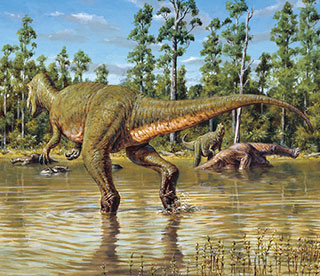
|
Search JoyZine with Google Site Search! |
Diamantinasaurus
Diamantinasaurus (meaning "Diamantina River lizard") is a derived titanosaurian dinosaur from late Albian (Early Cretaceous) rocks of Australia. The titanosaurs, are a group of sauropods known mainly from Gondwanan continents, and the largest terrestrial animals known. Diamantinasaurus and a second titanosaur, Wintonotitan, are the first new sauropods described from Australia in over 75 years. Diamantinasaurus was a relatively small titanosaur, from15-16m in length and 15 to 20 tonnes in weight. Titanosaurs were characterized by having bony osteoderms in the skin. However, although Diamantinasaurus has been reconstructed with rows of osteoderms along its back (reconstruction by Travis Tischler, Age of Australian Dinosaurs Museum of Natural History), no osteoderms have yet been found. Diamantinasaurus is based on AODL 603, a partial skeleton including a right shoulder blade, a sternal plate, much of the forelimbs, much of the hindlimbs except the feet, partial hips, and ribs. The limb bones were stout. Diamantinasaurus is interpreted as a lithostrotian, a group of titanosaurs characterized by the presence of bony osteoderms in the skin (‘litho’ meaning ‘stone’, and ‘strotia’ referring to skin). Lithostrotians tended to be comparatively small forms, in contrast to most other titanosaurs. Huge sauropods—probably titanosaurs—lived in Australia during the Cretaceous, evidenced by footprints left along the Broome coastline (the largest of which is 1.5m across) in Western Australia. Diamantinasaurus was described in 2009 by Scott Hocknull and colleagues. The type species is D. matildae, in reference to the folk song "Waltzing Matilda", which was written by Banjo Paterson in nearby Winton. A phylogenetic analysis found Diamantinasaurus to be a lithostrotian titanosaurian sauropod, in the same clade as sauropods such as Opisthocoelicaudia and Saltasaurus. Sauropods were herbivores, based on features of the skull and teeth as well as on their massive body size. However, there is little direct evidence of food preference other than tooth shape and wear facets. Edible plants known from the Winton Formation or from other areas of Cretaceous Australia include araucarian conifers, angiosperms, ginkgoes, cycads, ferns and horsetails. Unfortunately, since the skull and dentition of Diamantinasaurus are not preserved, its specific diet is unknown. Unique features of Diamantinasaurus include retention of metacarpal (hand bones) phalangeal facets and phalanges (fingers), with McII heavily reduced; possession of a manual ungual claw; flat distal humeral condyles; and subequal distal femoral condyles. Key features of the skull and dentition, however, can’t be assessed since cranial material has not yet been recovered. AODL 603 was found about 60km north-west of Winton, near Elderslie Station. It was recovered from the lower part of the Winton Formation, dated to the latest Albian. AODL 603 was found in a clay layer between sandstone layers, interpreted as an oxbow lake deposit. Also found at the site were the type specimen of the theropod Australovenator, bivalves, fish, turtles, crocodilians, and plant fossils. The Winton Formation had a faunal assemblage including bivalves, gastropods, insects, the lungfish Metaceratodus, turtles, the crocodilian Isisfordia, pterosaurs, and several types of dinosaurs, such as the theropod Australovenator, the sauropod Wintonotitan, and unnamed ankylosaurians and hypsilophodonts. Diamantinasaurus bones can be distinguished from Wintonotitan bones because Diamantinasaurus bones are more robust. Like other sauropods, Diamantinasaurus would have been a large quadrupedal herbivore. The Winton Formation is made up of sandstones, siltstones and claystones formed during the mid-Cretaceous Period (about 100 million years ago). At this time, the region was an extensive river plain filling the lowlands left behind by the retreating Eromanga Sea. The environment would have been a mosaic of large, winding rivers, freshwater pools, billabongs, swamps, lakes and coastal estuaries (a spectacular ‘dinosaur stampede’ was recorded in a mudflat deposit from the Winton area—known as the Winton Trackway). The climate would have been subtropical to temperate, with marked seasons and abundant rainfall. Fossil plants from the Winton Formation include angiosperms, araucarian conifers, ginkgoes and ferns. Australovenator, Diamantinasaurus and Wintonotitan are from the basal part of the Winton Formation, not far from the type locality of Lovellea wintonensis (an early flowering plant). |
